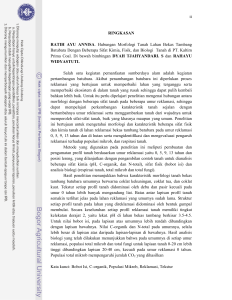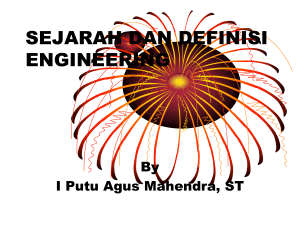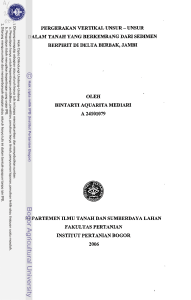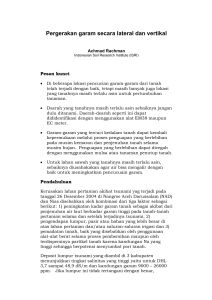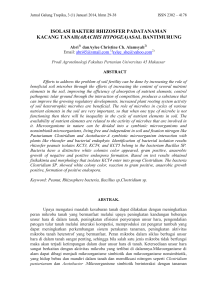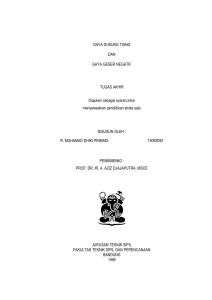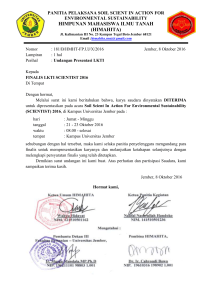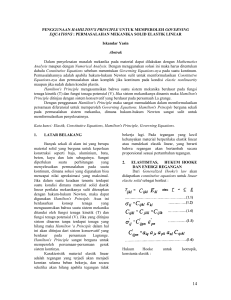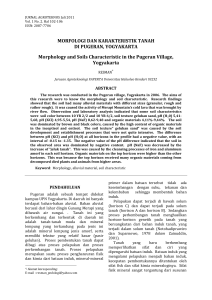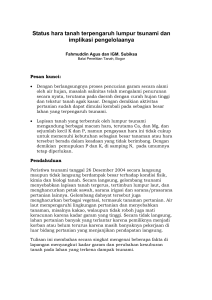MEKTAN sil 211
advertisement
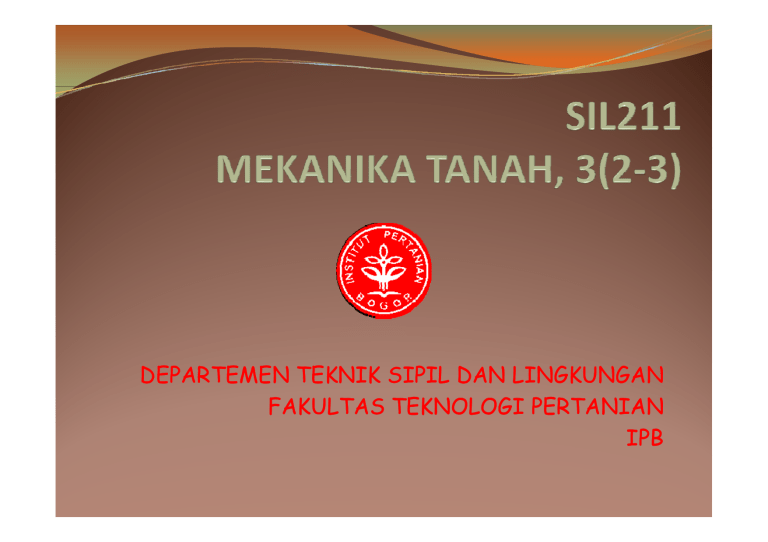
DEPARTEMEN TEKNIK SIPIL DAN LINGKUNGAN FAKULTAS TEKNOLOGI PERTANIAN IPB DESKRIPSI y Mempelajaritentang tanah sebagai bahan padat (asal tanah tanah, fase tanah, tanah konsistensi tanah, tanah struktur, klasifikasi tanah, elastisitas); hidrolika tanah; Sifat Sifat-sifat sifat mekanik tanah (distribusi tegangan, kekuatan tanah, konsolidasi tanah dan tekanan n n lateral r tanah); n ); D Dinding n ng p penahan; n n; Pondasi n dan Stabilitas tanah. TUJUAN INSTRUKSIONAL UMUM y Mahasiswa dapat menjelaskan tentang sifat dan perilaku tanah, baik tanah sebagai bahan penahan pondasi maupun tanah sebagai bahan material dalam penerapannya untuk rancangan pondasi dan k i kaitannya d dengan stabilitas bili tanah h KULIAH Pengajar: Dr. Dr Ir Ir. Erizal RB RB, M.Agr. M Agr (ERZ) dan Prof. Prof Dr. Dr Ir Ir. Asep Sapei, Sapei MS. MS (ASP) No. 1. 2. 3. 4. Pokok Bahasan Sub Pokok Bahasan 1. Pendahuluan Sifat-sifat elemen tanah 2. Sejarah Perkembangan Mekanika Tanah 3. Ruang Lingkup Mekanika Tanah (pemecahan masalah : perencanaan & pelaksanaan l k pondasi, d i perencanaan perkerasan, k bbangunan di bbawahh tanah t h& dinding penahan, perencanaan galian & timbunan, perencanaan bendungan tanah) 1. Definisi teknis dari tanah dan Istilah yang digunakan Sifat-sifat umum tanah t h 2. 2 Hubungan H b antara t butir b ti tanah, t h airi dan d udara d dalam d l masa tanah t h (tanah (t h 3 phase) h ) 3. Hubungan fungsiaonal elemen tanah 4. Batas-batas kekentalan/konsistensi tanah dan percobaan nya (batas cair, batas plastis, batas susut, batas lekat) 5 T 5. Tegangan netral t l ddan ttegangan efektif f ktif ttanahh 1. Pendahuluan Klasifikasi tanah 2. System klasifikasi tanah (texstural classification system, unified soil classification system, AASHTO system) 3 K 3. Karakteristik kt i tik ddasar ttanahh ((analisis li i pembagian b i bbutir, ti analisis li i hhydrometer) d t ) Stabilitas dan 1. Pendahuluan 2. Stabilitas tanah (mekanis dan kimiawi) Pemadatan tanah 3. Macam-macam stabilitas lapisan tanah dasar 4. Pemadatan tanah (tujuan, teori pemadatan, percobaan pemadatan di laboratorium (standard proctor, modified proctor dll) dan di lapangan (sanc cone test dll) Estimasi Waktu (menit) ( it) 2 x 50 2 x 50 2 x 50 2 x 50 No. Pokok Bahasan Sub Pokok Bahasan Pendahuluan Definisi CBR Percobaan CBR Jenis-jenis CBR (lapangan (lapangan, lapangan rendaman, rendaman dan laboratorium) Cara penaksiran dan penentuan nilai CBR Estimasi Waktu (menit) 2 x 50 5. Metoda Rasio Daya Dukung (CBR method) 1. 2. 3. 4 4. 5. 6. Hidrolika tanah 1. Air tanah 2. Air kapiler 3. Permeabilitas dan rembesan ( pendahuluan, hokum darcy, kecepatan debit dan kecepatan rembesan, penentuan koefisien permeabilitas constant head dan falling head permeability test) 4. Rembesan melalui beberapa lapisan endapan tanah 6 P 6. Pengaruhh gaya rembesan b terhadap h d stabilitas bili tanahh 2 x 50 7. Hidrolika tanah 1. Faktor keamanan terhadap bahaya pengapungan (up lift) 2. Piping dalam tanah karena aliran sekitar turap 3. Teori rangkak g ((creep) p) untuk rembesan di bawah bendungg 4. Perencanaan konstruksi berdasarkan teori Bligh 5. Rumus-rumus dasar penngaliran tanah 6. Jaring-jaring aliran (Flow Nets) 2 x 50 8 8. Konsolidasi tanah 11. Penurunan tanah 2. Teori konsolidasi 3. Test laborotorium konsolidasi 1 Dimensi 4. Tanah terkonsolidasi normal (normally consolodated), terkonsolidasi berlebih (over consolidated) consolidated), dan rasio konsolidasi berlebih (over consolidated rasio) 5. Penentuan parameter konsolidasi tanah: compression index, srinkage inidex, dan coefisien consolidated 6. Besar dan waktu penurunan (settlement) konsolidasi 2 x 50 No. Pokok Bahasan 9. Kekuatan Geser Tanah kohesi (c) dan sudut geser dalam tanah (Ø) 10. Distribusi tekanan vertikal 11. Daya dukung Pondasi Dalam Sub Pokok Bahasan 1. Kriteria keruntuhan Mohr – Coulumb (kemiringan bidang keruntuhan akibat geser, hokum keruntuhan geser pada tanah jenuh air) 2. Penentuan parameter kekuatan geser tanah di laboratorium (uji geser langsung, g g, ujij ggeser langsung g g kondisi air teralirkan ppada ppasir & lempung p g jjenuh air) 3. Uji Geser Triaxial (macam test: consolidated- drained test, consolidatedundrained, unconsolidated-undrained) 4. Sensitifitas dan Thixotropy py dari tanah lempung p g 5. Uji geser Vane di lapangan 1. Pendahuluan 2. Beban terpusat dan Beban merata 3. Metoda Fadum 4. Diagram Newmark 5. Hubungan tegangan vertical tanah dengan penurunan tanah akibat konsolidasi 1. Definisi dan jenis-jenis pondasi dalam (tiang pancang dan tiang bor) 2. Daya y dukungg axial tiangg tunggal gg berdasarkan rumus statis (p (parameter tanah hasil percobaan di laboratorium dan percobaan di lapangan) 3. Daya dukung axial tiang kelompok dan efisiensi kelompok 4. Penurunan tanah di bawah pondasi dalam 5. Daya y dukungg lateral ppondasi dalam 6. Daya dukung dinamis pondasi dalam Estimasi Waktu ( (menit) ) 2 x 50 2 x 50 2 x 50 No. Pokok Bahasan 12. Tegangan tanah lateral Sub Pokok Bahasan 1. Tegangan tanah lateral aktip dan pasip menurut teori Rankine dan teori Coulomb 2. Tegangan g g tanah lateral aktipp dan ppasipp akibat beban luar 3. Pengaruh air tanah pada tegangan tanah lateral 13. Konstruksi 1. Maksud dan tujuan penggunaan Dinding 2. Jenis-jenis Dinding Penahan Tanah (gravity wall, cantilever wall, dan t f t wall) ll) counterfort P h Penahan Tanah 3. Gaya-gaya yang bekerja pada Dinding Penahan Tanah 4. Tekanan tanah aktip dan pasip 5. Kestabilan dindingg ppenahan tanah: Keamanaan gguling, g, keamanan geser, keamanan daya dukung, keamanan terhadap kelongsoran, dan keamanan bahan konstruksi 14. Kemantapan 1. Macam-macam kelongsoran tanah lereng 2 K 2. Kestabilan t bil llereng menurutt cara: sliding lidi wedge d method th d ddan ffriction i ti circle method (Fellenius method dan simplified Bishop method) Estimasi Waktu (menit) ( it) 2 x 50 2 x 50 2 x 50 PRAKTIKUM No. 1. 2 2. 3. 4. 5. 6. 7 7. 8. 9 9. 10. 11. 12. Praktikum: Indeks Properties Atterberg Limits Analisis Butiran (analisis saringan dan hidrometer) Test kerucut pasir p Permeabilitas tanah Test Kompaksi T t CBR Test Test Geser Langsung Test Uniaxial Test Triaxial Pengukuran g Kekuatan Tanah di lapang p g Test Konsolidasi PENILAIAN y UTS y Praktikum/Tugas y Ujian Akhir : 30 % : 30 % : 40 % PUSTAKA y Bowles, B l J J.E., E 1986, 1986 Engineering E i i Properties P ti of f Soils S il and d Their Th i Measurements, McGraw Hill International Editions, New York y Braja M.Das, Principles of Foundation Engineering, Wadsworth, Inc., 1984 y Braja M.Das, Principles of Geotechnical Engineering, PWS-Kents P blishin Co., Publishing C 1985 y Craig, R.F., 1992, Soil Mechanics, Chapmann & Hall, London y McKyes, McKyes E., E 1989, 1989 Agricultural Engineering Soil Mechanics, Mechanics Elsevier, Amsterdam y Rosenak, S., 1963, Soil Mechanics, B.T. Batsford LTD, London y Ortigao, JAR., and Sayao, ASEJ., 2004, Handbook of Slope Stabilisation, Springer. DEFENISI (Wikipedia) ( p ) y Soil mechanics is a discipline that applies principles of engineering mechanics, ee.g. mechanics g kinematics kinematics, dynamics dynamics, fluid mechanics mechanics, and mechanics of material, to predict the mechanical behavior of soils. Together g with rock mechanics, it is the basis for solvingg manyy engineering problems in civil engineering (geotechnical engineering), geophysical engineering and engineering geology. Some of the basic th i off soilil mechanics theories h i are th the bbasic i ddescription i ti andd classification l ifi ti of soil, effective stress, shear strength, consolidation, lateral earth pressure bearing capacity, pressure, capacity slope stability stability, and permeability permeability. Foundations, embankments, retaining walls, earthworks and underground openings are all designed in part with theories from soil mechanics. TANAH: y Tanah adalah bagian kerak bumi yang tersusun dari mineral dan bahan organik. y Lapisan tanah yang subur y Tanah sangat vital peranannya bagi semua kehidupan di bumi karena tanah mendukung kehidupan tumbuhan dengan menyediakan hara dan air sekaligus sebagai b i penopang akar. k St Struktur kt ttanahh yang bberongga-rongga juga j menjadi j di tempat t t yang baik bagi akar untuk bernafas dan tumbuh. Tanah juga menjadi habitat hidup berbagai mikroorganisme. Bagi sebagian besar hewan darat, tanah menjadi lahan untuk hidup dan bergerak. y Dari segi klimatologi, tanah memegang peranan penting sebagai penyimpan air dan menekan erosi, meskipun tanah sendiri juga dapat tererosi. y Komposisi tanah berbeda-beda pada satu lokasi dengan lokasi yang lain. Air dan udara merupakan bagian dari tanah. GEOTECHNICAL ENGINEERING THE LEANING TOWER OF PISA Why Geotechnical Engineering? “Virtually Virtually every structure is supported by soil or rock rock. Those that aren’t - either fly, float, or fall over.” -Richard Richard Handy Handy, 1995 Case Study I: Building Foundation Weight of building (DL + LL) = 37,000 tons Weight of excavated soil = 29,000 tons 15-ft soft fill and organic silt 20 ft of sand and gravel 75 ft Soft Clay Soil Firm Soil or Bedrock Initial estimated settlement = 1 ft Estimated settlement due to the net load of clay (37,000 – 29,000 = 8,000 tons) = 2-3 in. Source: Lambe & Whitman, 1969 Building 10 on M.I.T.’s Campus – Photo by Professor Zoghi, Sept. 1984 Design and Construction Issues •How deep? •Size of the footing (mat foundation)? •Groundwater table? •Dewatering? •Braced B d excavation? ti ? •Damage to adjacent buildings? •Quantity and rate of the estimated settlement? •Stress distribution? •Design bearing capacity? Alternative Foundations •Pile e type type? •How deep? •Spacing? •Maximum allowable load? •Pile efficiency? •Driving/drilling? D i i /d illi ? •Optimum sequence of driving piles? •How much variation from vertical? •Adjacent buildings? C Case St Study d II II: Earth E th Dam D Zoned Earth Dam Source: Lambe & Whitman, 1969 Design and Construction Issues 9 Dimensions? (Most economical design) 9 Thickness of the rock facing and gravel to keep swelling of clay core to a tolerable amount? 9 The moisture content and compaction technique (lifts, equipment, etc) to place gravel and clay? 9 Permeability and seepage characteristics of the dam? 9 Consolidation and settlement characteristics of underlying soil? 9 Shearing g strength g p parameters? 9 Potential leakage under and through the dam? 9 Factor of safety of upstream and downstream slopes? 9 Rapid draw down effect? 9 Seismic activity? The Teton Dam, 44 miles northeast of Idaho Falls in southeastern Idaho, failed abruptly on June 5, 1976. It released nearly 300,000 acre feet of water, then l d l f f h flooded farmland and towns downstream with the eventual loss of 14 lives directly or indirectly and eventual loss of 14 lives, directly or indirectly, and with a cost estimated to be nearly $1 billion. http://www.geol.ucsb.edu/~arthur/Teton%20Dam/welcome_dam.html Teton Dam Failure - Flood waters advancing through Rexburg, Idaho. Landslides In excess of $1 billion in damages and 25 to 50 deaths each year in U.S. Loss of Support⇒Bridge pp g Collapse p – Kobe EQ Q Annual Damage in the U.S. Geo-Environmental y Municipal Solid Waste ¾ Approx. Approx 3.6 3 6 lbs trash per person per day ¾ Total trash = 216 million tons ¾ Make up: 40% Cardboard 18% yard waste 9% % metals 8% plastic others Landfills How to Prepare? Source: Coduto, 1999 Geotechnical Hall of Fame: G t h i l H ll f F http://www.ejge.com/People/HallFame.htm Charles Augustin de Coulomb y Grandfather of the Soil y y y y Mechanics 1736‐1806 (France) Friction and cohesion concepts Lateral earth pressures on retaining walls Structures, Hydraulics, Mathematics, Electricity, etc. William John Maquorn Rankine y 1820‐1872 (Scotland) y Thermodynamics and soil mechanics y Lateral earth pressure theoryy y Pioneering role as an engineering educator Karl von Terzaghi y The Father of Soil Mechanics y 1883 (Prague) – 1963 (Massachusetts) y Coined the phrase… y First publication in Fi bli i i 1925 y Great many G t contributions Arthur Casagrande y 1902 – 1981 y Worked closely with Terzaghi y Started soil mechanics at Harvard y Received numerous awards y Fundamental soil mechanics h i problems… Ralph Brazelton Peck y 1912 – Winnipeg, Canada y Co‐authored a textbook C h d b k with Terzaghi y Initially a bridge designer… y Several decades as a pioneering foundation g engineer and educator y Numerous awards Alec Westley Skempton y 1914‐2001 (UK) y Established soil mechanics at Imperial College y Soil mechanics problems, rock mechanics, geology, ,g gy, and history of civil engineering g g Nilmar Janbu y 1920 ‐ y NTNU – NTNU Norway y Ph.D. student of Casagrande at Harvard y Slope stability p y problems – Janbu Method y Landslides in quick‐ L d lid i i k clay Laurits Bjerrum y 1918‐1973 y The First Director of NGI (1951‐1973) y Quick clay y Progressive failure of slopes y A A “Giant” Giant Harry Bolten Seed y 1922 – 1989 y Father of Geotechnical Earthquake Engineering y UC Berkley y Pioneering work in Geohazards
